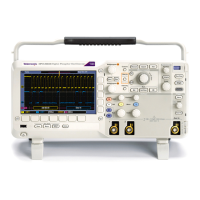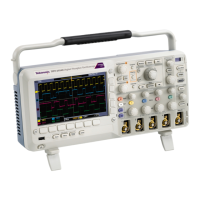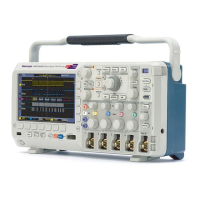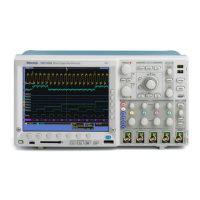Specifications
Table 4: Trigger specifications (cont.)
Characteristic Description
Pulse-type runt trigger sensitivity,
typical
0.75 division from DC to maximum bandwidth
Aux In does not support Pulse trigger
Pulse-type trigger width sensitivity,
typical
3.5 ns when only using digital channels D0-D7
4.5 ns when using any of the digital channels D8-D15
Aux In does not support Pulse trigger
For all vertical settings, the minimums are:
Trigger type Pulse width Re-arm time Time between
channels
1
Logic Not applicable 2 ns 1 ns
Time Qualified
Logic
4ns 2ns 1ns
Aux in does not support Logic trigger
Logic-type triggering, minimum logic
or rearm time, typical
1
For Logic, time between channels refers to the length of time a logic state derived from
more than one channel must exist to be recognized. For Events, the time is the minimum time
between a m ain and delayed event that will be recognized if more than one channel is used.
Minimum clock period for setup/hold
time violation trigger, typical
User Setup Time + User Hold Time + 2 ns, with positive User Times
Feature Min Max
Setup time
–100 ns 2 s
Hold time –1 ns 2 s
Setup + Hold time 2 ns (Setup and
hold times cannot
both be negative)
4s
Setup/hold violation trigger, setup
and hold time ranges
Input coupling on clock and data channels must be the same.
For Setup time, positive numbers mean a data transition before the clock.
For Hold time, positive numbers mean a data transition after the clock edge.
Setup + Hold time is the algebraic sum of the Setup Time and the Hold Time programmed by
the user.
Aux in does not support this trigger type
Pulse class Minimum pulse
width
Minimum rearm time
Runt 2 ns 2 ns
Width 2 ns 2 ns
Rise/Fall time
2ns 2ns
Pulse type trigger, minimum pulse,
rearm time, minimum transition time
For the trigger class width and the trigger class runt, the pulse width refers to the width of the
pulse being measured. The rearm time refers to the time between pulses.
For the trigger class Rise/Fall time, the pulse width refers to the delta time being measured.
The r earm time refers to the time it takes the signal to cross the two trigger thresholds again.
Rise.fall time trigger, delta time
range
4nsto8s
Aux in does not support this trigger type
6 DPO2000 and MSO2000 Series Specifications and Performance Verification

